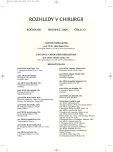-
Medical journals
- Career
The Czech Republic Register of Injuries (ÚRČR) – Experience with the Database Management in the Brno Faculty Hospital
Authors: M. Krtička; L. Plánka 1; D. Ira; M. Mašek; P. Gál 1
Authors‘ workplace: Klinika úrazové chirurgie FN Brno a LF MU, přednosta: doc. MUDr. Michal Mašek, CSc. ; Klinika dětské chirurgie, ortopedie a traumatologie FN Brno, přednosta: prof. MUDr. Petr Gál, Ph. D., MBA 1
Published in: Rozhl. Chir., 2009, roč. 88, č. 12, s. 716-719.
Category: Monothematic special - Original
Overview
Introduction:
Injuries are the leading cause of mortality in age group of people junior to 45 years. Central data collection is important to survey basic injury causation and trauma care quality. The Czech Trauma Registry was started in 2004. The aim of study was to discover valid statistic analysis from current data collection and its clinical practice contribution.Patients and methods:
Doctors working in the Centre of trauma care (University hospital Brno) collect and enter data to the Trauma Registry. Data collection is practiced continuously through the hospitalization. Abbreviated Injury Scale and Injury Severity Score are used for injury severity determining. In the University hospital Brno 161 patients (159 patients met validity criterion) were entered in trauma registry.Results:
159 patients were evaluated, Injury Severity Score was 16–75, demographically from 6 regions. Traffic accident was the most frequent cause of injury. Average inpatient age was 43 years. Mortality in our patient file was 10.7%. Investing sum for 1 patient who was returned to Trauma Registry was 209 019 Czech crowns.Discussion:
Authors confront their results with the German Trauma Registry, results in basic parameters are analogous. Data collection should be proceeding correctly. Czech Trauma Registry should be the instrument of quality management and is waiting for its statutory provision.Conclusion:
Trauma registry is going to afford plenty information for pre-hospital and hospital care improvement.Key words:
injury – polytrauma – trauma registry – data collection
Sources
1. Sethi, D., Racioppi, F., Baumgarten, I., Vida, P. Injuries and violence in Europe: why they matter and what can be done. WHO Regional Office for Europe, Copenhagen 2006.
2. Champion, H. R., Copes, W. S., Sacco, W. J., et al. The major trauma outcome study: establishing national norms for trauma care. J Trauma 1990; 30 : 1356–1365
3. Pollock, D. A., McClain, P. W. Trauma registries current status and future prospects. JAMA, 1989; 262 : 2280–2283
4. Plánka, L., Starý, D., Škvařil, J., Gál, P. Národní registr dětských úrazů. Úrazová chirurgie, 2008; 3 : 65–68.
5. Ministerstvo zdravotnictví České republiky: Věstník MZČR částka 6, 2008 : 55–63.
6. Mann, N. C., Mullins, R. J., MacKenzie, E. J., et. al. Systematic review of published evidence regarding trauma system effectivenes. J. Trauma., 1999; 47 : 25–33.
7. Frykberg, E. R. Triage: principles and practice. Scand. J. Surg., 2005; 94 : 272–278.
8. American Association for Automotive Medicine. The Abbreviated Injury Scale, 2008 Revision, Arlington Heights IL 60005.
9. Champion, H. R., Sacco, W. J., Copes, W. S. Improvement in outcome from trauma centre care. Arch. Surg., 1992; 127 : 333–338.
10. Ruchholtz, S., Lefering, R., Paffrath, T., Bouillon, B., Sektion NIS der DGU Traumaregister der Deutschen Gesellschaft für Unfallchirurgie. Trauma Berufskrankheit, 2007; 9 : 270–278.
Labels
Surgery Orthopaedics Trauma surgery
Article was published inPerspectives in Surgery

2009 Issue 12-
All articles in this issue
- Management of Deep Device Related Infection in Patient Implanted with Mechanical Cardiac Support Device Using V.A.C. System
- Injuries of Posterior Dudoenal Wall
- Can the Sacral Spongiosa Bleeding Cause Fatal Complications of Unstable Pelvic Fracture?
- Blunt Carotid Injury
- Management of Diaphyseal Forearm Fractures Using LCP Angle- Stable Fixation Devices and Intramedullary Nailing
- The Czech Republic Register of Injuries (ÚRČR) – Experience with the Database Management in the Brno Faculty Hospital
- Intraoperative Angioplasty and Cross-Over Bypass with Aorto-Bifemoral Bypass in Revascularization of Iliac Arteries
- Comparison of Oncological Outcomes between Laparoscopic and Open Procedures in Non-Metastazing Colonic Carcinomas
- Liver Cystadenoma
- Colorectal Malignancies with Respect to Hemocoagulation
- Perspectives in Surgery
- Journal archive
- Current issue
- Online only
- About the journal
Most read in this issue- Management of Diaphyseal Forearm Fractures Using LCP Angle- Stable Fixation Devices and Intramedullary Nailing
- Liver Cystadenoma
- Blunt Carotid Injury
- Intraoperative Angioplasty and Cross-Over Bypass with Aorto-Bifemoral Bypass in Revascularization of Iliac Arteries
Login#ADS_BOTTOM_SCRIPTS#Forgotten passwordEnter the email address that you registered with. We will send you instructions on how to set a new password.
- Career

